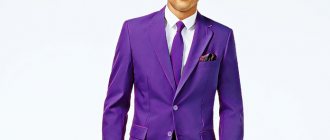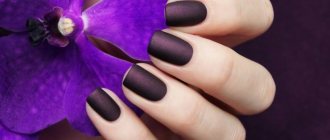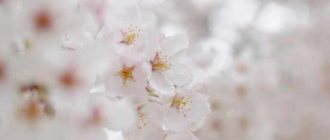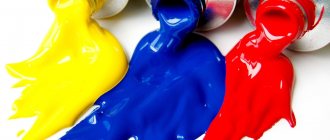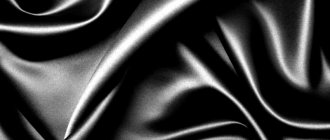Greetings, friends!
Purple is the most mystical of all colors. Already in ancient times, people saw in it some kind of magical attraction. This color was chosen by sages and magicians for their robes; it denoted everything mysterious and veiled. Even the starry sky is sometimes depicted as purple to give it mysticism and mystery. Today we will talk about how the color purple affects the human psyche, what it is associated with and what can be said about people who prefer things of this color.
Psychology of color in women's clothing
Women spend significantly more time choosing their wardrobe than men. Intuitively, with the help of the main tone of the outfit, they convey to others their desire to either stand out or go into the shadows.
For example, the predominance of red in a woman’s clothing indicates her unconscious influence on the men around her. By doing this, the girl tries to look more attractive and sexier in the eyes of the stronger sex, which indicates her dissatisfaction with her personal life. Nevertheless, dark and pastel colors do not always indicate depression, because the choice of outfit is largely influenced by both the momentary mood and the character of the person.
In addition, women of all ages are inherently quite emotional and are capable of acquiring something completely uncharacteristic for them. That’s why almost every woman’s wardrobe is often full of colors and the style changes depending on her mood.
Concert of the week
Denis Matsuev and RNMFO “August. Return of live sound"
Music of freedom: first concert at the Moscow Philharmonic after quarantine
The first of the capital's musical institutions to interrupt the forced pause was the Philharmonic, right at the fort. On August 7, pianist Denis Matsuev and the Russian National Youth Philharmonic Orchestra conducted by Valentin Uryupin took to the stage of the Tchaikovsky Hall. Tickets for the event were completely sold out, taking into account the fact that, according to the requirements of Rospotrebnadzor, only half of the seats went on sale, and the rest went to the “angels of acoustics” (this is the inscription that was displayed on the empty seats).
Another sign of the era is that the audience wore masks, but the orchestra members did not. There were no newfangled safety devices like plastic flaps. Finally (the last concession to the pandemic), the evening passed without an intermission, and the main program turned out to be a little more concise than we are used to: Tchaikovsky’s Romeo and Juliet Overture and Rachmaninov’s Third Piano Concerto. However, with excellent comperes by Yaroslav Timofeev, two encores by Matsuev (one of which - a piano version of the play “In the Cave of the Mountain King” by Grieg - sounded very ominous in the half-empty dark hall) and his own humorous story about how a speculator offered him a ticket for this evening.
Perhaps it would be symbolic not to broadcast this concert, to leave it in a purely offline space. But the Philharmonic preferred a different strategy and invited music lovers to share the joy of the return of live sound, at least remotely. Well, this is also a spirit of the times - by no means the worst.
What kind of people like it?
Collecting data on personality characteristics, psychologists identify some character traits that are often inherent in lovers of shades of green.
- Those who prefer this range are quite reasonable and balanced. They strive to be objective, so it is easy to do business with them and simply communicate with them.
- Love for bright shades of color speaks of great willpower and determination. Such a person is not prone to excessive daydreaming; he is clearly aware of his capabilities and determines his plans and tasks based on them.
- Those who are drawn to green shades are excellent conversationalists. They can easily become the leader of a company or team. They often have a fairly wide social circle, and they easily make new acquaintances and establish contacts.
- Another positive quality of those who love green is their honesty. They do not accept intrigue and achieve their goals through hard and conscientious work.
- People who prefer shades of green are very merciful. They are ready to support their loved ones and friends in difficult situations. Reacting negatively to cruelty and injustice, they try to do everything in their power to correct or prevent bad things.
- Green lovers are often members of charitable organizations and actively donate funds to various social causes.
Unfortunately, this quality is often taken advantage of by unscrupulous people, playing on a sincere desire to help in trouble.
Those who prefer green shades are very inquisitive. They like to travel, develop, learn and master new skills and professions. They strive to work on their shortcomings and constantly improve.
Professions related to communication are suitable for them - teacher, doctor, social worker, consultant. They often realize themselves in the field of art. At least, most often, each of them has at least one or even several hobbies related to creativity and creativity.
If a person prefers the rich and bright color of green in his clothes, this indicates that he has a large amount of vital energy. Such people are very active and practically cannot sit still.
Men who prefer green colors are very balanced and caring. They become wonderful, sensitive husbands who protect their family.
Negative characteristic
Despite the many positive properties, some variations of this color also have negative sides.
Too much when surrounded by very bright colors, such as sea green, can cause overstimulation of the nervous system. People prone to nervous breakdowns, anxiety and emotional swings can react especially clearly to this.
As mentioned above, calm shades of green are successfully used in relaxation therapy. However, this property of color also contains a not entirely positive effect.
Those who experience severe neuro-emotional exhaustion and apathy should not surround themselves with such a range. Pale and light tones of greenery in this case will lead to an even greater loss of strength and loss of energy.
How does it affect your well-being?
The influence of the color violet on the human psyche is in most cases beneficial. The calming effect on the autonomic nervous system is manifested in a decrease in heart rate and equalization of breathing. Blood pressure is normalized, anxiety, the intensity of panic attacks and other manifestations of vegetative-vascular dystonia are relieved.
It is easier for a person to open up his subconscious, his inner world. Strengthening and expanding awareness, this color has a positive effect on the properties of memory and attention, and helps to notice details. Stimulates mental activity in terms of making the right decisions.
Let's look at the main effects of using purple.
- Deep layers of memory, repressed memories are revealed.
- The ability to put you into a trance state helps you relax, relieve stress, and immerse yourself in healing rest and sleep.
- Color relieves unpleasant experiences, helps to look at accumulated problems in a new way, without anxiety, to see ways to solve them, restoring mental balance.
- Exposure to gentle violet before bed promotes deeper, more restful sleep.
- Therapy using violet color helps restore damaged tissues and organs, the body after injury or surgery. It is believed that its influence helps to cope even with mental trauma and intense experiences.
- Purple color also affects appetite. Along with blue, it helps reduce it.
- Observations by color therapists prove the ability of violet to improve vision with long-term training in focusing visual attention on the object in question.
An “overdose” of purple is also possible. Excessive color intensity or exposure to it for too long can negatively affect the nervous system. Possible depression, excessive self-control and, as a result, overexertion and depression. It is worth considering the possibility of using the effects of purple color by “unscrupulous” people, misleading or even trance for the purpose of deception.
The practice of using violet in meditation and spiritual practices helps to find peace, put thoughts in order, balance the mental state, and restore harmony in the body and nervous system. Violet helps to cleanse thoughts from anxieties, fears, grievances, outdated attitudes, and sets us up for the manifestation of pure, selfless love, connecting us with the universal collective thought. Helps you feel one with the universe, strengthening self-esteem and awakening a sense of well-being and success.
When exposed to certain shades of violet, overall well-being improves, mood improves due to the activation of creative processes and the birth of inspiration for creative activity.
Health effects
Brown has proven itself well in the field of color therapy. It can be used as a means to improve overall health. People who treat him with disdain, as a rule, do not think about their well-being.
Color has the following effects on physical and mental health:
strengthens the immune system warms the body, relaxes muscles slows down metabolic processes, reduces heart rate and blood pressure stimulates brain function by improving blood circulation improves cognitive functions - memory, concentration, thinking has a calming effect on the nervous system, relieves stress, prevents depression, helps sleep relieves aggression, anger, irritation , evens out the emotional background, reduces anxiety, restlessness, helps fight phobias
Brown also increases the level of confidence, stimulates performance and endurance. It is believed that with its help it is possible to improve the situation in the team, increase the cooperation of people, and reduce conflict.
* * *
The color brown has undeservedly few fans. The list of its positive properties is huge. It calms, balances, harmonizes and warms.
This is the color of home comfort, care, peace and tranquility in the family and in one’s own soul. Stylish, elegant and discreet, it is perfectly used in clothing and interior design, business and marketing.
The beneficial effects of brown color on physical and emotional health allow it to be widely used for medicinal purposes.
How to choose the right color of clothes?
Knowing what effect a particular color has on your interlocutor, and correctly using this knowledge in practice, you can win him over to your side:
- red helps a person striving for success achieve their goals, eliminates doubts and encourages them to make the right choice;
- if an important meeting is planned, at which you will need to quickly make informed decisions, you should give preference to a blue suit;
- green helps to cope with excessive anxiety and recharges your energy;
- white will help convince the interlocutor of the correctness of the desired point of view and win him over;
- yellow calms, promotes creativity and mental activity;
- Psychology attributes the color violet with the ability to enhance a person’s intuition; it also helps to overcome one’s inner fears and cope with melancholy;
- For people seeking to make a career in trade, the color orange will help them recharge with optimism and positivity and make it easier to establish contact with partners.
With the help of the right color of clothing, you can manipulate people around you, making them think that they themselves made this or that decision.
What is color psychology and how is it used?
Color psychology studies the mental and emotional effects that colors have on people. It describes individual characteristics as well as common impacts.
Certified practicing psychologist, founder of the center for the popularization of practical psychology Vadim Kurkin talks, for example, about the following effects:
- Warm colors (red, yellow, orange) are associated with a variety of emotions. This can range from a feeling of comfort and joy to hostility or anger.
- Cool colors (green, blue, purple) evoke calmness or sadness.
Knowledge of color psychology is applied in various aspects.
Color in interior design and clothing selection
The psychology of color is relevant for designers who are planning renovations and choosing a range to decorate certain rooms. Calm, cold tones are recommended for bedrooms, and bright colors are used to decorate living rooms and kitchens. The color scheme is important when decorating offices and workspaces.
Knowledge of color psychology helps in creating a wardrobe and choosing clothes for different events. The brighter the color and the more contrasting the tones, the faster you will find yourself in the center of attention; cold tones will make you inconspicuous.
Diagnosis of psychological state
Magic of color: Freepick
The Luscher color test is used to assess a person’s psycho-emotional state. He is well known to psychiatrists and psychologists, marriage counselors, criminologists, doctors and recruitment agents:
- The full version of the test has seven tables and 73 colored fields. There is a simplified version with eight colors.
- During the test, a person sequentially selects colors from the most to the least pleasant.
- Based on the choice, they draw conclusions about the mental and sometimes physical state of a person, the characteristics of his behavior, fears, inclinations, and relationships to the world around him.
Psychology of color in advertising and marketing
Different colors can make a person feel hungry, stimulate positive or negative emotions, instill confidence, a sense of calm, or stimulate activity. The shade of the packaging and the product itself is of great importance to the buyer, even if he does not think about it.
Even the color of the tablets affects their effectiveness. Therefore, modern marketers take into account the specific color scheme of products.
Lovers of gray
The few lovers of gray are reserved, uncommunicative, non-public people who avoid social contacts. However, with a rich inner world.
Adherence to ashy tones speaks of a desire to disappear into the crowd, to become invisible. But this does not mean that such a person is easy to influence: she has clear and strict beliefs, from which she does not deviate. And it is extremely difficult to change the opinion or subjugate a gray lover. Preferring initially not to stand out, he simply avoids unpleasant disputes.
The tendency to reason thoroughly, on the one hand, plays into one’s hands and allows one to make the most rational choice. On the other hand, this trait makes everyday life difficult, and the final decision is often made when the problem has exhausted itself.
Lovers of smoky colors sensitively and subtly perceive the world around them. But they can rarely express it: there are few creative personalities among them, although they may well become writers or artists. But such people are excellent analysts and perform well in solo work. They make excellent accountants, engineers, logisticians, secretaries, economists and scientists. But due to avoidance of publicity and reluctance to establish extensive business connections, they rarely achieve great success or career heights.
Risk and innovation are not the strong point of such people. They carefully think through and weigh everything. They are characterized by conservatism and some orthodoxy. Adherents of gray rarely use new products, preferring, albeit outdated, but proven options.
It is difficult to communicate with lovers of gray tones because of their isolation: they rarely talk about their lives or share their experiences. But they are excellent listeners who delve into the problems of others and give practical advice.
The character is also affected by what shades of gray a person prefers. Adherents of light people are more open and sociable, easy-going and easy-going. Dark lovers are gloomy, gloomy, tired of life and obligations. And those who prefer silver and pearl tones reflect the essence of the phrase “a thing in itself”: they are selfish, closed in on their own problems and experiences.
What does love and loathing for purple mean?
A person's preferences can tell a lot about their character, and colors are just as important here as other interests.
Since purple is contradictory in nature, people who love it often have internal conflict. They differ from others in their versatility. They are attracted by everything unusual, mysterious and unexplored, but the material world interests them much less.
For this reason, such individuals are often infantile. There are many teenagers among them. By the way, in adolescence I really loved purple, I bought a lot of clothes and jewelry in this color.
Lovers of purple are more likely than others to be melancholic, prone to depression, and difficult to perceive negativity. They withdraw into themselves, engage in soul-searching, analyze their personality and love solitude.
Psychologists also note the following features:
- pessimism;
- increased interest in the inner world;
- vulnerability, high sensitivity;
- gentleness, desire to avoid conflicts;
- tendency to succumb to the influence of others, high suggestibility.
Unconsciously, people who choose purple want to attract attention and be recognized.
If a person categorically dislikes purple, most likely he is down-to-earth and rational. Straightforward individuals who love certainty and do not tolerate ambiguity are unlikely to love purple. They often reject mysticism and do not believe in omens. They have highly developed logic, but lack creativity.
Purple color in psychology
The color purple, deep and beautiful, is associated with spirituality, intuition, creativity and intellectual abilities of a person. This is a mysterious, mystical and enigmatic color.
Violet combines two color principles - blue and red. Therefore, it includes calm and violence at the same time.
This Color in some incomprehensible way connects opposites: independence and submission, power and weakness, wisdom and naivety, earthly and divine.
Purple color in psychology
Purple color is one of the most mysterious in the entire color spectrum. It is located at the very end, as if it represents the crown of their development, the unity of all colors.
In fact, purple is a truly beautiful symbol of the unity of opposites, because it is obtained from a mixture of two colors: red and blue.
These shades are completely opposite both in appearance and in their symbolism.
https://youtube.com/watch?v=GIgp8e8w2Tw
The color violet in psychology personifies not only the unity of opposites and negations, but also the dissolution, destruction of these opposites in it and the creation of something extremely new and previously unseen. This is precisely the mysticism and mystery of purple.
A person who gives preference to this color tends to lead a dreamy lifestyle; he does not want to put up with generally accepted norms, but builds his own reality, understandable only to him, with his own rules, principles and values.
Unlike the obvious “red” leader, “purple” people never strive for high positions, but, on the contrary, possessing innate intuition, remain on the sidelines and become, as it were, secret advisers to the first leaders.
Purple is the color of people born under the constellation Sagittarius
Purple is a dangerous color. It puts pressure on the psyche and causes apathy. At the same time, purple increases low self-esteem. Sometimes purple is chosen by people who find it difficult to realize themselves in life. They are usually very critical of themselves. They always control themselves very rationally.
Violet awakens in a person the desire for spiritual growth, gaining power over himself and his life. In psychology, the color violet secretly and unobtrusively makes itself felt in the area of the subconscious and intuitive thinking.
Often “violet” people cannot give a logical explanation for their actions and thoughts, but on a sensory level they are confident that they are right.
The color purple enhances suggestibility.
A hypnologist, a specialist in inducing hypnosis, often uses objects of this color to quickly induce trance in his patients. This property of violet can also be used by various charlatans. An excess of this color makes you sleepy and lulls your vigilance.
This color is also known for its ability to positively influence human memory. He awakens the earliest, repressed memories, which are difficult to get to the bottom of without his help.
Purple color as a symbol
On a subconscious level, this color is perceived as a symbol of everything mysterious and otherworldly. This is magic, astrology, esotericism, healing. Looking at the paintings depicting various magicians and witches, you can see that most often they are wearing purple robes. Purple symbolizes the other world, with which only a select few have the right to communicate.
In the Middle Ages, this color was considered mourning. However, it could still only be worn by members of the royal family. The custom of associating this shade with noble sorrow has been preserved in the Orthodox Church. During fasting, priests wear vestments of this particular shade.
It is believed that purple promotes inner concentration, detachment from the world, which is necessary for spiritual cleansing.
Shades of purple
- The color purple characterizes extravagance, unusualness bordering on strangeness, and artistry.
- Dark purple color symbolizes rudeness and authority.
- Lilac color (light purple) calms anxiety and symbolizes intuition; has a mild, non-intensive effect, improves vision (pansies contribute to this).
- Lilac color – vanity, immaturity, chosen in adolescence.
Purple color in psychology
Meaning in different cultures
In the Middle Ages, mourning outfits were made from lilac fabrics. They were worn if someone from the royal family died.
In ancient times in Russia, after the death of her husband, a wife had to wear black clothes for six months, showing her grief. For the next six months, dark purple was allowed, less often - gloomy blue or green. On this basis, a superstition arose that lilac is a widow's color and should not be worn to a wedding.
In ancient Rome, women wore wreaths of violets to show their spiritual and physical purity and abstinence. And the ancient Egyptians associated purple with the part of the soul that remained to live on earth after the death of a person. This element was called "Ba" and was represented in the form of a bird.
In South America, purple is widely used on the Day of the Dead (November 1st and 2nd).
The color purple was given great importance in China. It symbolized noble birth, but, unlike yellow, it was not intended only for rulers. In the philosophy of Taoism, the “purple cloud coming from the East” is the main symbol that distinguishes the followers of Tao (the way of knowing things).
Does it affect health?
Everything that surrounds us affects our general condition and health in one way or another. Dark colors worsen your mood, while light colors, on the contrary, are considered healing. The lilac color is considered unnatural among some peoples, and therefore carries negative notes.
But others consider it the exquisite “color of kings,” bringing goodness and positivity to its owner. And again the lilac color speaks of its inconsistency. How do such mysterious and incomprehensible tones as lilac and violet affect the human psyche and state?
We already know that this controversial color can also carry medicinal properties. This effect occurs by “tickling” brain activity. At a subconscious level, our understanding tries to divide it into components, that is, into red and blue colors, and this causes the nervous system to be excited. And then our chakras and other senses of perception of reality are activated.
Color therapy has been widely used around the world for a long time. So, with the help of lilac shades, experts have learned to heal insomnia and nervous agitation. This shade helps reduce headaches (toothaches). It helps improve the condition of the liver, kidneys and bladder. It is used for colds.
To do this, some experts recommend keeping a set of bedding in the house that is exclusively lilac in color. As soon as someone close to you feels bad, their bed is decorated with a purple or lilac shade.
In addition, when treated with lilac, a person’s chakras are activated. One of them is sahasrara, which is directly connected with the entire Universe. Through it, a person receives the necessary energy for healing and replenishment.
This suggests that a gradual improvement in the functioning of the natural way of life is taking place. And after these actions, the launch of systems of rejuvenation and activation of vitality begins. A person begins to feel the world and the surrounding nature. He joins the general tone, and then his energy abilities increase significantly.
There are some other advantages to using lilac (lilac or violet) color. With these shades you can get rid of shyness and indecisiveness. And this will increase your self-esteem and establish you in society.
For example, if you want to go to university or find a good job, then start actively using the magic of color. Lilac color is just what you need. Just surround yourself with things or crystals (amethyst) that will serve as helping talismans. Believe it and you will see positive results.
Remember that everything depends on your desire. As soon as you begin to act, your intuition (it is directly connected with the Cosmos) will help and tell you in which direction to move.
Single of the week
Mobilization of Moby: artists call to forget about problems
What to listen to this week in self-isolation
Moby "My Only Love"
Moby's new single from the album All Visible Objects is a free cover version of the Roxy Music song of the same name. Strictly speaking, quite little remains of the original here - only the chorus motif and harmonic sequence, and the general appearance of the composition is completely different. Instead of a rock ballad, there is peppy electronica, which, however, is more catchy: Moby is a master of creating musical “hooks” that can reliably catch the listener.
However, despite the “frivolous” genre, the theme and purpose of the track are the most serious. This is evidenced by the animated clip - a heart-warming paraphrase of a scene from Avatar, where cruel people barbarously burn the jungle, sparing neither the natives nor the animals. In the blurb, Moby explains that he wanted to “remind people of the dangers of climate change and forest destruction.” In the music, of course, no threat or tragedy is felt. But the only line of the chorus - “my only love” - knowing the author’s idea, you begin to perceive differently: it’s not about a person, but about nature.
We combine
Beige color goes well with a wide variety of tones, here are the most successful combinations:
With white. This combination looks fresh and elegant, it is often used in business attire, as well as in summer looks. To make the outfit look more interesting, the tandem of white and beige can be diluted with bright accessories - blue, red, orange.
With black. The combination of light beige and black looks elegant, but not as formal as a white and black set. Therefore, this combination is often used when creating business images.
With red. These two colors complement each other perfectly. Beige “restrains” the passion of red, and red, on the contrary, enlivens beige clothes.
With brown. The duet of these two colors looks feminine and gentle. It can be used to create business and romantic looks.
With green. The combination of these two colors is the main feature of the “military” style, since these are the tones of military camouflage.
With pink. This is a spectacular duo, ideal for summer looks.
With purple. The combination can look either strict or romantic, everything will depend on the shades of color used for the combination. Light shades are a good choice for feminine looks, dark ones for business looks.
Beige looks great with both bright and pastel colors
Want to attract attention? Combine beige with rich burgundy, blueberry, and azure. When creating romantic images, it is better to combine beige with soft lilac, silver-gray, light pink
Album of the month
We're in the cabin: Taylor Swift's quarantine songs and Chrissie Hynde's pep
What July music albums are worth paying attention to?
Deep Purple "Whoosh!"
Complaining that Deep Purple are “not the same anymore” sounds like a platitude, albeit not without foundation. And yet, every new album of the “dark purple” becomes an event. The next long-play will not be an exception - proof that the authors of Smoke on the Water do not at all intend to turn into monuments to themselves. Classic 1970s hard rock on Whoosh! much less than experiments. In some tracks the musicians go into psychedelic territory; in Nothing at All a rather extensive allusion to Bach suddenly appears, and in What the What, on the contrary, Gillan and his comrades rely on old-fashioned rock and roll.
How to perceive such eclecticism is the question. On the one hand, listening to the album is certainly interesting. You never know what tricks the musicians will pull not only in the next number, but even in the next section of the current composition. On the other hand, this disparate set of ideas does not add up into a single artistic statement. But is it really that important? The main thing is that the spectacular guitar and keyboard solos are still present, Ian Gillan is in the same vocal form as he was 10 and 20 years ago, and the musical material is very good in places.
Use in clothing
Attitudes towards brown clothing have changed over the centuries. If in the past it was worn only by plebeians and peasants who worked on the land, then during the Renaissance it began to be preferred by the nobility. It was believed that the aristocracy was more suited to dark and restrained tones, while ordinary people could wear flashy colors.
Now brown is one of the most common colors in the wardrobe. It is especially often used for outerwear - fur coats, sheepskin coats, jackets. It is also suitable for shoes - boots, boots, moccasins. Brown is often used for bags, gloves, hats and scarves, and vests.
Things of this shade are suitable for many events. But brown tones in a wardrobe are considered ideal for work, business, and business relationships. This is the color of serious, practical and sensible people who know how to work and rely on their own strength. Therefore, you can safely wear brown things to an interview to make the right impression on the HR manager.
The color suits people with “Autumn” and “Spring” color types best. Both dark-skinned and light-skinned people look advantageous in it; you just need to choose the right shades. Another advantage of brown is its practicality: it is completely non-staining.
This color gives the appearance maturity. If you don’t want to look older, you should use it sparingly and dilute it with other colors. Then the image will be fashionable and effective. However, for a romantic date, psychologists advise choosing lighter and lighter colors: brown is not conducive to playfulness and flirting.
Meaning, harm and benefit
Blue has its pros and cons. The positive points include:
- wisdom;
- pacification;
- spirituality;
- tolerance;
- purification of the soul;
- development of intuition;
- great achievements.
Negative ones include:
- complacency;
- rancor;
- imbalance of emotions;
- weakness;
- the occurrence of depression;
- drug addiction may develop.
Blue color meaning:
- determination, resolution of conflict situations, determination - characteristic of diplomats;
- perfectionism, the need for fulfillment - characteristic of creative people, writers and philosophers;
- strong-willed qualities of a leader - typical for politicians and people with oratorical abilities.
If we consider the psychology of relationships, then for a woman this color determines fidelity, devotion to tradition, and stability.
Blue indicates a state of peace, balance. If a person likes a given color, this determines his melancholy, modest behavior, and the need to feel confident. The favorable attitude of the environment is of great importance.
Most of all, people need blue at certain periods of life, when there is illness, overwork, or when there is resentment. If someone is opposed to blue and its shades, it is an indicator that he is eager to comprehend certain changes, wants to give up the routine in life, he may have a fear of responsibility and making important decisions. Such persons may be concerned about the opportunity to become famous and get more money, and in a simple way.
How does color affect a person?
It has long been known that the right choice of colors when decorating a room can work wonders. It not only decorates the interior and creates a positive mood for the people in it, but also supports a person in his endeavors.
For example, there are color combinations that help to significantly increase productivity and make work easier, create a calm and cozy environment conducive to good conversation and relaxation.
In addition, with the help of color you can form an idea of objects, their beauty and purpose. Color allows you to emphasize certain details in the room and hide others.
There is a whole science that studies the influence of color on a person in the interior, but it is closely related to other areas of human knowledge. It is at the intersection of psychology, physiology, physics, lighting engineering and art history that you can learn how and why color affects our bodies.
Long-term studies and observations have revealed that the colors of the short-wave part of the spectrum (blue, green, cyan) and the long-wave part of the spectrum (yellow, red, orange) affect different parts of the human nervous system. Therefore, the first group of colors began to be called cold, and the second - warm.
Warm colors affect us like coffee in the morning. They temporarily tone the nervous system, briefly increasing a person’s performance, and then bright, flashy colors begin to depress it - and the person has no resources left for active activity. These colors are great for sports facilities.
On the contrary, cool colors in the interior calm the nervous system. They help to use the body’s resources wisely and maintain performance longer. In addition, they allow you to quickly relieve tension and calm a person. These colors are great for rooms where you have to do mental work and often work at the computer.
There is a special group of colors: shades of the middle part of the spectrum (blue-blue, green-blue, yellow-green colors) and mixed soft pastel colors (green-gray, gray-blue, turquoise colors). Their effect on humans is most favorable. They have a calming, calming effect.
Psychologists and painters know that color affects a person, causing certain emotions. In addition, in different psychological states we can perceive the same color differently. In addition, historically it has developed that certain colors contain clear symbolism - state, religious, secular. Using this body of knowledge, designers select colors for the interior.
The magical meaning of purple
The mystery of dark purple makes it popular among magicians and sorcerers. Items of this color are used in the occult. Talismans made of stones or purple fabrics have the following properties:
- enhance magical abilities;
- improve sleep;
- develop intuition;
- help influence other people.
Lilac is also closely associated with romantic experiences, therefore it is used to increase one’s attractiveness and charm.
Brown color in the interior
It is present almost everywhere in interior design. Usually furniture and room doors have this color, since they are made mainly of wood. In the interior, brown tones create an atmosphere of coziness, reliability and convenience, and improve family relationships.
They look especially good in the bathroom, kitchen and living room. In the dining room, they will improve appetite, but will not lead to overeating, as they stimulate moderation in everything. A study room where all the furniture has shades of dark wood will look great.
In a nursery you can use it within reasonable limits. It harmonizes the child’s personality and balances it. But to prevent the room from looking gloomy and austere, you need to make bright accents, just like in the bedroom.
Soft brown shades create the illusion of warmth. Therefore, they look especially good in the decoration of rooms facing north, or any rooms where it is too cool, according to the owners.
It is appropriate to use brown color in the work space. It stimulates ability to work, perseverance, attentiveness, and puts you in a businesslike mood. It is also recommended to dilute it with white or golden accents.
General value
Purple color is the result of mixing red and blue. This is the shortest wavelength radiation perceived by human vision.
The color scheme is called royal. In Byzantine times it was extremely difficult to obtain. For clarity: to prepare 30 g of paint, 250,000 mollusks with ink secretion were required. The dye was unusually durable and bright. But not everyone could use it, only rich and powerful people.
The situation changed only in the 19th century, when people learned to produce synthetic dyes. They cost much less. But purple still retained the name royal.
Purple is considered the most mystical color, which is why it is important in many religions. In Hinduism, the seventh chakra is colored in it, which is responsible for the connection of a believer with the cosmos. According to Feng Shui, color signifies spirituality and aristocracy. In Christianity it is sadness, affection, silence. In Islam it is a mirage, and in Buddhism it is a mentor, a spiritual father.
Interesting Facts
It is generally accepted that the violet spectrum belongs to cool shades. During the Middle Ages it was used for sewing mourning clothes. It was worn in the event of the death of the king or one of his family members.
Among the Incas, the color purple meant a person dominating a territory.
In Argentina, there lived a purple bear in a zoo. No, this is not a separate species. Originally he was white. But after taking medicine for dermatitis, the color changed. This is how the allergy manifested itself.
The meaning of clothing color in psychology
Psychology believes that contemplation of color has an impact on the human psyche, up to sudden mood swings
Therefore, it is important to choose an outfit so that it does not irritate either the owner or others during the day.
Red
Psychology considers a lover of the color red in clothes as an extraordinary, strong personality with clearly expressed leadership qualities. This is the color of love and passion, on the one hand, and aggression, on the other. A person who prefers red is impulsive, ambitious, often assertive and selfish.
Orange
Although orange shades in the spectrum are adjacent to red, this color has the opposite meaning. Orange lovers are intellectually developed, active, good-natured and sociable. A rich orange tone is difficult for the brain to perceive, causing psychological exhaustion, so you should wear such tones with care.
Yellow
In psychology, the color yellow in clothing is associated with the sun, warmth, and cheerfulness. Yellow has a positive effect on mental activity, fights chronic fatigue and prolonged depression. People who love this shade are always in a good mood, open and sociable. However, they are often very critical of themselves and others.
Green
Green symbolizes assertiveness, toughness and firmness. The choice of green clothing speaks of a person’s desire for constancy, his desire to assert himself. At the same time, green lovers subconsciously want to be liked by others; they lack public recognition.
Blue
Blue has a dual effect on the human psyche. On the one hand, this color calms, on the other hand, if it is not diluted with other tones, it causes anxiety and even a state of depression. People who choose outfits in blue tones are distinguished by reliability and calmness.
Blue
Blue is associated with the sky, sublimity, and spirituality. Blue evokes trust and respect and promotes a feeling of peace. People wearing blue clothes are intellectually developed, creative and positive. It is easy to find a common language and establish contact with them.
Lilac
The lilac color in clothes psychologically causes feelings of anxiety and concern in others. You should not wear lilac tones when going to negotiations, as the interlocutor may feel rejected. Lilac lovers are people prone to melancholy and depression. Surrounding themselves with lilac tones, they unconsciously plunge deeper into a state of depression. Psychologist-hypnologist Nikita Valerievich Baturin will help you get out of this state.
Violet
The psychology of purple in clothing speaks of a person’s desire to be realized in this life. People who prefer purple shades are critical of themselves, prone to self-control, but at the same time they are in dire need of support and support. They are sentimental and sensitive. Saturated purple shades can cause apathy, as they put significant pressure on the psyche.
Pink
Pink shades relieve irritation, pacify anger, and have a relaxing effect on the psyche. Pink lovers need protection and love. Such people are easily excitable and often become restless for any reason. They are frivolous, looking for vivid sensations and impressions.
Grey
Psychology explains the choice of gray in clothing by the desire not to stand out, to be inconspicuous. People who dress in shades of gray are afraid of being seen and often have low self-esteem. At the same time, they are open, good-natured, responsible, you can rely on them and trust them.
White
In psychology, white clothing is associated with purity and perfection. People who often wear white clothes are neat, punctual, decent and sincere with others. This color has a positive effect on the human psyche and makes people feel good about themselves; it’s not for nothing that health workers wear white coats.
Black
Psychology explains an excess of black in clothes with self-doubt and the desire to hide from the surrounding reality. Often this indicates mental anguish, internal depression, melancholy and a state close to depression. However, this is not always the case. Psychology explains the color black in a woman’s clothing as aggressiveness towards others. With this she wants to show independence and self-sufficiency. For men, it is a symbol of rigor, efficiency, and practicality.
Brown
In psychology, the brown color of clothing symbolizes earth, life, and fertility. People who prefer brown tones clearly know their goals and go towards them. They are success-oriented, practical and serious, and indulgent towards dreamers. Brown brings a sense of stability, suppresses anxiety and restlessness.
What does purple, lilac color mean for women?
Violet color is very often classified as a so-called feminine color, since it is quite bright, eye-catching, passionate, but at the same time gentle, deep and mysterious.
Women who love purple and lilac colors have a number of characteristics. Here are the main ones:
- These people are individualists. For such women, freedom of speech, thought, and self-expression is above all. They never allow anyone to limit themselves in anything and always independently make all decisions that affect them.
- Extremely emotional individuals. Women who have a craving for such colors are more emotional than all others. They are quite easily thrown off balance; they do not know how to hide their feelings and emotions. If a purple lover wants to cry, she will cry; if she wants to laugh loudly, she is welcome; kissing a stranger is easy. Women do not see anything bad or harmful in their emotionality.
- Vulnerable and defenseless. Despite such a fiery character, these girls need support, support, a strong shoulder. They are highly sensitive and take everything to heart.
Women
- Lovers of purple live according to the rules and foundations that they consider correct and true. It must be said that next to such women there can only be those people who completely share their worldview and interests.
- If a woman has never paid attention to the color purple, lilac , and now suddenly falls in love with it, she should expect serious changes. Very often, such changes include the birth of a child, since purple is considered the color of pregnancy.
- Also, the color purple for a woman means her confidence in herself and her abilities. Internally, such women feel this power, but outwardly it may not manifest itself at all.
The influence of red color on humans
Red and scarlet are rich shades. They allow you to move the needle, increase your tone, get a charge of vigor and activity, and feel a surge of strength. If you cannot make the right decision, you are afraid to carry out your plans, then the red color will relieve you of all doubts and help you make the right choice faster. You will be able to correctly place emphasis, look at the situation more clearly, and evaluate priorities. Red color will give you strength to fight for your opinion and your point of view. Even if you think that all decay and vitality have left you, then red can change everything for the better. You will quickly get back on your feet, gain vigor and fortitude.
The red chakra adds strength and endurance to people. Moreover, height, weight and other physical data do not matter; even short and frail-looking people show extraordinary abilities. This is noticeable to others; usually they do not enter into arguments with such people, do not create conflict situations, since they note that a leader is standing in front of them. But excessive activity of the red chakra can negatively affect behavior. Aggression and excessive temper appear. People become intolerant and become jealous more often. Too much activity also affects other energy centers, so a person cannot achieve his goal. After all, on the path to a dream, only the red chakra is not enough; the influence of other stimuli is also necessary. Red should be used in moderation. According to experts, red color works best in the morning. It helps you wake up and recharge your batteries for the whole day. This color can also be used in situations where you need to cheer up, fill with determination and ambition. Historians also note the positive influence of the color red on humans. Many medieval coats of arms and flags use this color in their symbolism. He showed military power, the desire for conquest and victory. Moreover, color affects not only successes in military affairs. It is also associated with the erotic sphere, with passion and love. Red is a symbol of persistence, activity, strength and danger.
Red also has a positive effect on the human body - it stimulates blood circulation, improves metabolism, the functioning of the cardiovascular system, and immunity. The effect of red can be noticed after a long walk in the cold. When you need to warm up in a hurry, there's nothing better than red wool socks. This color is chosen by people with low blood pressure and circulatory problems. But if the pressure is high, then it is better to exclude red. The same applies to various bleedings. In such situations, it is worth using a minimum of red or completely replacing it with orange.
Meaning in different religions
In Buddhism, violet is highly valued for its connection with the seventh chakra, Sahasrara. This is the highest (crown) energy center, responsible for spiritual enlightenment and obtaining heavenly knowledge. This chakra is located in the crown area.
The importance of purple is also in the religion of the Jews - Judaism. In ancient times, priests wore purple robes. Bedspreads for ceremonial ceremonies were made from material of this color.
In the art of early Christianity, dark purple symbolized restraint, long-suffering, and also sadness. And in Catholicism they depicted an angel in purple clothing, who embodied the sacrament of the priesthood.
